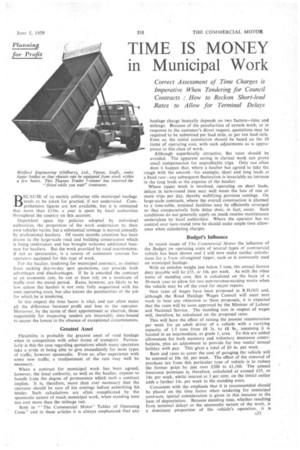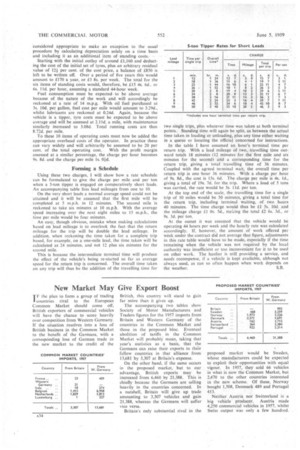TIME IS MONEY in Municipal Work
Page 99

Page 100

If you've noticed an error in this article please click here to report it so we can fix it.
Correct Assessment of Time Charges is Imperative When Tendering for Council Contracts : How to Reckon Short-lead Rates to Allow for Terminal Delays
BECAUSE of its mainly utilitarian role municipal haulage tends to be taken for granted, if not underrated. Comprehensive figures are not available, but it is estimated that more than £15n-s. a year is spent by local authorities throughout the country on this account.
Dependent upon the policies adopted by individual authorities, the proportion of the work undertaken by their own vehicles varies, but a substantial tonnage is moved annually by professional hauliers. Of recent months attention has been drawn to the large-scale road and building construction which is being undertaken and has brought welcome additional business for hauliers. But the work provided by road maintenance, if not so spectacular, is a source of consistent revenue for operators equipped for this type of work.
For the haulier, tendering for municipal contracts, as distinct from making day-to-day spot quotations, can provide both advantages and disadvantages. If he is awarded the contract at an economic rate, he can at least rely on a modicum of traffic over the stated period. Rates, however, are likely to be low unless the haulier is not only fully acquainted with his own operating costs, hut also knows the peculiarities of the job for which he is tendering.
In this respect the time factor is vital, and can often make all the difference between profit and loss to the operator. Moreover, by the terms of their appointment or election, those responsible for inspecting tenders are invariably duty-bound to accept the lowest in the absence of exceptional circumstances.
' Greatest Asset .
Flexibility is probably the greatest asset of road haulage when in competition with other forms of transport. Particularly is this the case regarding quotations which many operators take a pride in being able to give immediately for most types of traffic, however spasmodic. Even so, after experience with some new traffic, a readjustment of the rate may well be necessary.
When a contract for municipal work has been agreed, however, the local authority, as well as the haulier, expects to benefit from the degree of permanence which such a contract implies. It is, therefore, more than ever necessary that the operator should be sure of his castings before submitting his tender. Such calculations are often complicated by the spasmodic nature of much municipal work, when standing time can cost more than the mileage run.
Both in — The Commercial Motor' Tables of Operating Costs" and in these articles it is always emphasized that any haulage charge basically depends on two factors—time and mileage. Because of the peculiarities of certain work, or in response to the customer's direct request, quotations may be required to be submitted per lead mile, or per ton lead mile. Even so, the initial calculation should be based on the 10 items of operating cost, with such adjustments as is appropriate to this class of work.
Although superficially attractive, flat rates should be avoided. The apparent saving in clerical work can prove small compensation for unprofitable trips. Only too often does it happen that, where a haulier has agreed to take the rough with the smooth—for example, short and long leads at a fixed rate—any subsequent fluctuation is invariably an increase in the long leads at the expense of the haulier.
Where tipper work is involved, operating on short leads, delays in turn-round time may well mean the loss of one or more trips per day, thereby nullifying previous costings. On large-scale contracts, where the overall construction is planned to a time-table, terminal facilities may be efficiently arranged so that comparatively little delay does, in fact; occur. Such conditions do not generally apply on much routine maintenance undertaken by local authorities. Where the operator has no control over turn-round time he should make ample time allowance when calculating charges.
Budget's Influence
In recent issues of The Commercial Motor the influence of the Budget on operating costs of several types of commercial vehicle has been shown and I will now make similar calculations for a 5-ton oil-engined tipper, such as is commonly used on municipal haulage.
With an unladen weight just below 3 tons, the annual licence duty payable will be £35, or 14s. per week. As with the other items of standing cost, this is calculated on the basis of a 50-week year to allow for two non-revenue-earning weeks when the vehicle may be off the road for major repairs. • New rates of wages have been proposed in R.H.(65) and, although the Road Haulage Wages Council will meet next week to hear any objection to these proposals, it is expected that the rates will be soon approved by the Minister of Labour and National Service. The standing cost in respect of wages will, therefore, be calculated on the proposed rates.
This will have the effect of raising the present remuneration per week for an adult driver of a vehicle with a carrying capacity of 1-5 tons from £8 3s. to £8 8s., assuming it is located in an intermediate, or grade 1, area. To this are added allowances for both statutory and voluntary insurance contributions, plus an adjustment to provide for two weeks' annual holiday with pay. This gives a total of £9 4s. per week.
Rent and rates to cover the cost of garaging the vehicle will be assessed at 10s. 6d. per week. The effect of the removal of purchase tax from this particular type of vehicle is to reduce the former price by just over £200 to £1,160. The annual insurance premium is, therefore, calculated at around £35, or 14s. per week, whilst interest at 3 per cent, on the initial outlay adds a further 14s. per week to the standing costs.
Consistent with the emphasis that it is recommended should be placed on the time factor when tendering for municipal contracts, special consideration is given in this instance to the item of depreciation. Because standing time, whether resulting from terminal delays or the spasmodic nature of the work, is a dominant proportion of the vehicle's operation, it is considered appropriate to make an exception to the usual procedure by calculating depreciation solely on a time basis and including it as an -additional item of -standing costs: Starting with the initial outlay of around £1,160 .and deducting the cost of the initial set of tyres, plus an arbitrary residual value of 12i per cent. of the cost price, a balance of £850 is left to be written off. Over a period of five years this Would amount to £170 a year,. or £3 8s. per week. The total for the six items of standing costs would, therefore, be £15 4s. 6d., or 6s. lid, per hour, assuming a standard 44-hour week.
Fuel consumption must be expectedto be above average because of the nature of the work and. will accordingly be reckoned at a rate of 14 m.p.g. With oil fuel purchased at 3s. 10d. per gallon, fuel cost per mile would amount to 3.29d., whilst lubricants are reckoned at 0.24d. Again, because the vehicle is a tipper, tyre costs must be expected to be above average and will be assessed at 2.11d. a mile, with maintenance similarly increased to 3.08d. Total running costs are thus 8.72d. per mile.
To these 10 items of operating costs must now be added the appropriate overhead costs of the operator. In practice these can vary widely and will arbitrarily be assumed to be 20 per cent, of the total operating cost. With the profit margin assessed at a similar percentage, the charge per hour becomes 9s. 8d.• and the charge per mile ls. Ofd.
Farming a Schedule
Using these two .charges, I will show how a rate schedule can be formulated to give the charge per mile and per ton when a 5-ton tipper is engaged on comparatively short leads. An accompanying table lists lead mileages from one to 10.
• On the very short leads a normal average speed could not be 'attained and it will be assumed that the first mile will be completed at 5 m.p.h. in 12 minutes. The second mile is reckoned to take six minutes at 10 m.p.h. With the average speed increasing over the next eight miles to 15 m.p.h., the time per mile would be four minutes.
An easy, though obvious, mistake when making calculations based on lead mileage is to overlook the fact that the return mileage for the trip will be double the lead mileage, in addition, when reckoning the time taken for a complete trip based, for example, on a one-mite lead, the time taken will be calculated as 24 minutes, and not 12 plus six minutes for the second mile.
This is because the intermediate terminal time will produce the effect of the vehicle's being re-started so far as average speed for the return trip is concerned. The overall time taken on any trip will thus be the addition of the travelling time for two single trips, plus whatever time was taken at both terminal points. Standing time will again be split, as between the actual time taken in loading or unloading, plus any time either waiting in a queue or locating the official concerned for instructions.
In the table I have assumed an hour's terminal time per return trip. With a lead mileage of two, travelling time outward totals 18 minutes (12 minutes for the first mile and six minutes for the second) and a corresponding .time for the return trip, giving a total travelling time of 36 minutes. Coupled with the agreed terminal wait, the overall time per return trip is one hour 36 minutes. With a charge per hour of 9s. 8d., the cost is 15s. 6d. The charge per mile is 4s. Id., giving a total of 19s. 7d. for the trip. Where a load of 5 tons was carried, the rate would be 3s. lid, per ton:
At the top end of the scale, the travelling time for a single trip of 10 miles would be 50 minutes, giving a total time for the return trip, including terminal waiting, of two hotirs 40 minutes. The time charge would thus be £1 5s. 10d. and the Mileage charge £1 Os. 5d., making the total £2 6s. 3d., or 9s. 3d. per ton.
At the outset it was assumed that the vehicle would be operating 44 hours per week and the hourly rate was calculated accordingly. If, however, the amount of work offered per week under the contract did not average that figure, adjustments in this rate table would have to be made, especially if the time remaining when the vehicle was not required by the local authority was insufficient or too inconvenient for it to be used on other work. The haulier is still, providing a service, and needs recompense, if a vehicle is kept available, although not always used, as can so often happen when work depends on
the weather. S.B.




































































































































